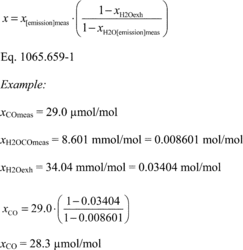['Air Programs']
['Air Emissions']
07/11/2024
...
(a) If you remove water upstream of a concentration measurement, x, correct for the removed water. Perform this correction based on the amount of water at the concentration measurement, xH2O[emission]meas, and at the flow meter, xH2Oexh, whose flow is used to determine the mass emission rate or total mass over a test interval. For continuous analyzers downstream of a sample dryer for transient and ramped-modal cycles, you must apply this correction on a continuous basis over the test interval, even if you use one of the options in §1065.145(e)(2) that results in a constant value for xH2O[emission]meas because xH2Oexh varies over the test interval. For batch analyzers, determine the flow-weighted average based on the continuous xH2Oexh values determined as described in paragraph (c) of this section. For batch analyzers, you may determine the flow-weighted average xH2Oexh based on a single value of xH2Oexh determined as described in paragraphs (c)(2) and (3) of this section, using flow-weighted average or batch concentration inputs.
(b) Determine the amount of water remaining downstream of a sample dryer and at the concentration measurement using one of the methods described in §1065.145(e)(2). If you use a sample dryer upstream of an analyzer and if the calculated amount of water remaining downstream of the sample dryer and at the concentration measurement, xH2O[emission]meas, is higher than the amount of water at the flow meter, xH2Oexh, set xH2O[emission]meas equal to xH2Oexh. If you use a sample dryer upstream of storage media, you must be able to demonstrate that the sample dryer is removing water continuously (i.e., xH2Oexh is higher than xH2O[emission]meas throughout the test interval).
(c) For a concentration measurement where you did not remove water, you may set xH2O[emission]meas equal to xH2Oexh. You may determine the amount of water at the flow meter, xH2Oexh, using any of the following methods:
(1) Measure the dewpoint and absolute pressure and calculate the amount of water as described in §1065.645.
(2) If the measurement comes from raw exhaust, you may determine the amount of water based on intake-air humidity, plus a chemical balance of fuel, DEF, intake air, and exhaust as described in §1065.655.
(3) If the measurement comes from diluted exhaust, you may determine the amount of water based on intake-air humidity, dilution air humidity, and a chemical balance of fuel, DEF, intake air, and exhaust as described in §1065.655.
(d) Perform a removed water correction to the concentration measurement using the following equation:

[73 FR 37335, June 30, 2008, as amended at 76 FR 57462, Sept. 15, 2011; 79 FR 23804, Apr. 28, 2014; 86 FR 34566, Jun. 29, 2021]
READ MORESHOW LESS
['Air Programs']
['Air Emissions']
Load More
J. J. Keller is the trusted source for DOT / Transportation, OSHA / Workplace Safety, Human Resources, Construction Safety and Hazmat / Hazardous Materials regulation compliance products and services. J. J. Keller helps you increase safety awareness, reduce risk, follow best practices, improve safety training, and stay current with changing regulations.
Copyright 2024 J. J. Keller & Associate, Inc. For re-use options please contact copyright@jjkeller.com or call 800-558-5011.
